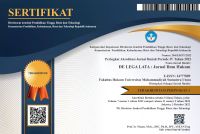Kajian Tentang Penggunaan Alat Bukti Petunjuk Oleh Jaksa Penuntut Umum Dalam Perkara Pencabulan Anak
Abstract
An indication is used to increase the judge's confidence that the accused is guilty or not. Instructions obtained from witness statements, letters and from the defendant's statement were put together, then put together and will make a clue that can strengthen the judge's conviction that the defendant is guilty or not. Not only that, evidence such as sperm found around the victim's vagina, damage to the blood membrane (hymen) and the victim's panties are also tools to strengthen evidence to prove that the victim has raped herself. It is unlikely that reports of rape will occur after a few days after the incident, because it is feared that the necessary evidence will be weak or no longer visible, making it difficult for the judge to believe that rape has occurred. This writing uses normative juridical legal research methods (normative research) with descriptive analytical research specifications that use secondary data. The procedure of data collection is in the form of documentation of notes or quotations, search of legal literature, books and others related to the identification of problems both offline and online, which are then analyzed through the content analysis method (content analysis method) with a focus on issues about how the legal basis the use of evidence from the Public Prosecutor as a means of proving the case of molestation of children, how is the process of using evidence from the Public Prosecutor as a means of proof of sexual abuse cases against children.
Keywords
Full Text:
PDFReferences
Atmasasmita, Romli. (1983). Bunga Rampai Hukum Acara Pidana. Jakarta: Bina Cipta.
Atmasasmita, Romli. (1995). Kapita Selekta Hukum Pidana dan Kriminologi. Bandung: Mandar Maju.
Dirdjosisworo, Soedjono. (1983). Pengantar Ilmu Hukum. Jakarta: Rajawali Pers.
Farid, Abidin, A.Z. (1981). Sejarah dan Perkembangan Asas Opportunitas di Indonesia. Ujung Pandang: UNHAS.
Hamzah, Andi. (2014). Hukum Acara Pidana Indonesia. Jakarta: Sinar Grafika.
Hamzah, Andi., & Dahlan, Indra. (1984). Perbandingan KUHP, HIR dan Komentar. Jakarta: Ghalia. Indonesia.
Harahap, M Yahya. (2001). Pembahasan Permasalahan dan Penerapan KUHAP Penyelidikan dan Penuntutan. Jakarta: Sinar Grafika.
Harahap, M. Yahya. (2007). Pembahasan Permasalahan Dan Penerapan KUHAP (Pemeriksaan Sidang Pengadilan), Banding, Kasasi, dan Peninjauan Kembali. Jakarta : Sinar Grafika.
Harahap, M. Yahya. (2018). Pembahasan Permasalahan dan Penerapan KUHAP. Jakarta: Sinar Grafika.
Lamintang, P.A.F. (1997). Dasar-dasar Hukum Pidana Indonesia. Bandung: Citra Aditya Bakti.
Marzuki, Peter Mahmud. (2011). Penelitian Hukum, Jakarta: Kencana Prenada Media Group.
Nugroho, Hibnu. (2010). Bunga Rampai Penegakan Hukum di Indonesia. Semarang: Badan Penerbit Undip.
Samosir, Djisman C. (1985). Jaksa dan Hakim dalam Proses Pidana. Bandung: Binacipta.
Seokanto, Sorejono., & Muji, Sri. (1996). Pengantar Penelitian Hukum. Jakarta: UI Press.
Seokanto, Sorejono., & Muji, Sri. (2003). Penelitian Hukum Normatif Suatu Tinjauan Singkat, Jakarta: Rajawali Pers.
Undang-Undang Nomor 1 Tahun 1946 tentang Kitab Undang-Undang Hukum Pidana (KUHP).
Undang-Undang Nomor 23 Tahun 2002 Tentang Perlindungan Anak.
Undang-Undang Nomor 3 Tahun 1997 Tentang Pengadilan Anak.
Undang-Undang Nomor 8 Tahun 1981 tentang Kitab Undang-Undang Hukum Acara Pidana (KUHAP).
DOI: https://doi.org/10.30596/dll.v3i2.3159
Refbacks
- There are currently no refbacks.
Address:
Faculty of Law, University of Muhammadiyah Sumatera Utara Jl. Kapten Mukhtar Basri No. 3 Medan, Kode Pos 20238
E-mail: delegalata@umsu.ac.id
Telp/HP/WA : 081262664567
DE LEGA LATA: Jurnal Ilmu Hukum is abstracting & indexing in the following databases:
De Lega Lata: Jurnal Ilmu Hukum is licensed under a Creative Commons Attribution-ShareAlike 4.0 International License.
Statcounter









